Supply Chain Management: Risks and Mitigation
VerifiedAdded on 2020/05/16
|11
|2595
|123
AI Summary
This assignment delves into the complexities of supply chain management by examining various types of risks businesses face. It analyzes methods for mitigating these risks, emphasizing the crucial role of Enterprise Resource Planning (ERP) systems. Drawing on academic sources, industry best practices, and case studies, the assignment aims to provide a comprehensive understanding of how organizations can effectively manage supply chain risks and enhance operational resilience.
Contribute Materials
Your contribution can guide someone’s learning journey. Share your
documents today.
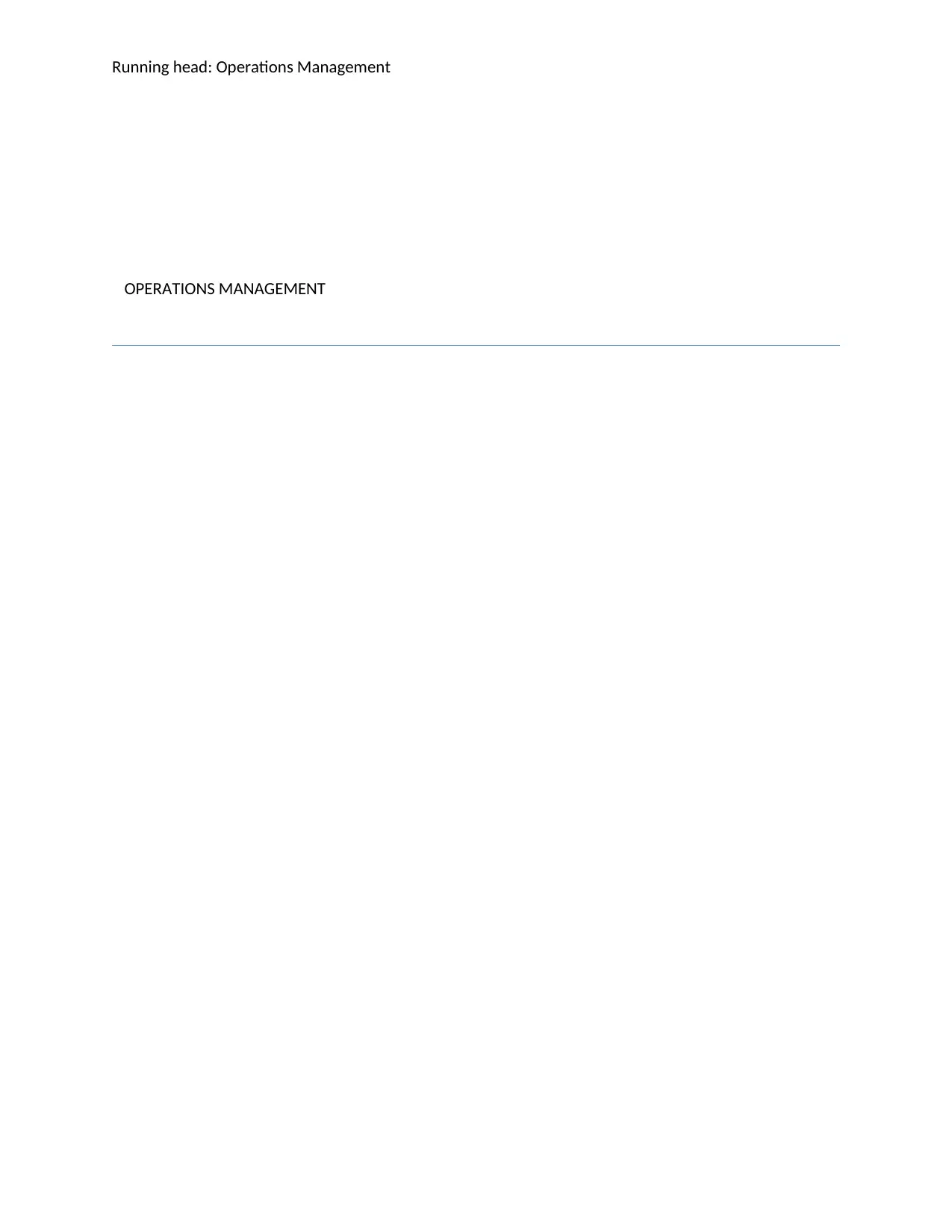
Running head: Operations Management
OPERATIONS MANAGEMENT
OPERATIONS MANAGEMENT
Secure Best Marks with AI Grader
Need help grading? Try our AI Grader for instant feedback on your assignments.

Operations Management 1
Executive Summary
Supply Chain Management comprises of dealing with customer and seller relationships. It
comprises of the product flow methodologies, inventory movement and storage. . It is considered
as the main principle of supply chain management. It is based on procurement, relocation and
managing the operations related to stock. Thus inventory plays a crucial role in supply chain
management as it lies at the heart of the process.
Supply Chain Management is the important component of the inventory control processes of the
Coca Cola Great Britain (CCGB). The CCGB which is headquartered at London, UK is the
subsidiary of the Coca-Cola Company. The supply chain management plays a key role in the
regulation and control of the flow of products and services of Coca Cola Great Britain.
In this report, inventory and supply chain operations would be analyzed with reference to Coca
Cola Great Britain operations in United Kingdom. Also the risk associated with the automated
processes and the suggestions for their mitigation and various financial evaluation techniques
would be stated herewith.
Executive Summary
Supply Chain Management comprises of dealing with customer and seller relationships. It
comprises of the product flow methodologies, inventory movement and storage. . It is considered
as the main principle of supply chain management. It is based on procurement, relocation and
managing the operations related to stock. Thus inventory plays a crucial role in supply chain
management as it lies at the heart of the process.
Supply Chain Management is the important component of the inventory control processes of the
Coca Cola Great Britain (CCGB). The CCGB which is headquartered at London, UK is the
subsidiary of the Coca-Cola Company. The supply chain management plays a key role in the
regulation and control of the flow of products and services of Coca Cola Great Britain.
In this report, inventory and supply chain operations would be analyzed with reference to Coca
Cola Great Britain operations in United Kingdom. Also the risk associated with the automated
processes and the suggestions for their mitigation and various financial evaluation techniques
would be stated herewith.
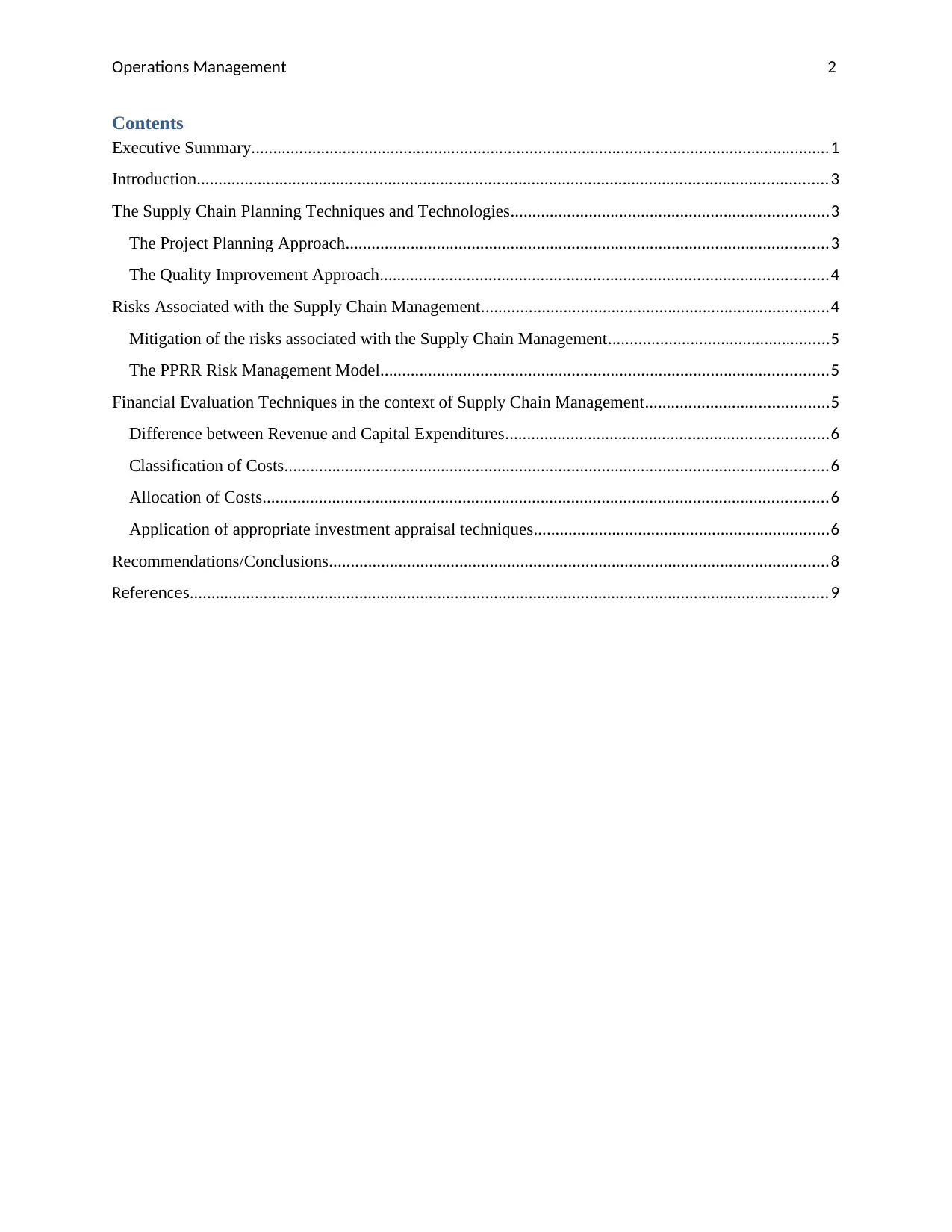
Operations Management 2
Contents
Executive Summary.....................................................................................................................................1
Introduction.................................................................................................................................................3
The Supply Chain Planning Techniques and Technologies.........................................................................3
The Project Planning Approach...............................................................................................................3
The Quality Improvement Approach.......................................................................................................4
Risks Associated with the Supply Chain Management................................................................................4
Mitigation of the risks associated with the Supply Chain Management...................................................5
The PPRR Risk Management Model.......................................................................................................5
Financial Evaluation Techniques in the context of Supply Chain Management..........................................5
Difference between Revenue and Capital Expenditures..........................................................................6
Classification of Costs.............................................................................................................................6
Allocation of Costs..................................................................................................................................6
Application of appropriate investment appraisal techniques....................................................................6
Recommendations/Conclusions...................................................................................................................8
References...................................................................................................................................................9
Contents
Executive Summary.....................................................................................................................................1
Introduction.................................................................................................................................................3
The Supply Chain Planning Techniques and Technologies.........................................................................3
The Project Planning Approach...............................................................................................................3
The Quality Improvement Approach.......................................................................................................4
Risks Associated with the Supply Chain Management................................................................................4
Mitigation of the risks associated with the Supply Chain Management...................................................5
The PPRR Risk Management Model.......................................................................................................5
Financial Evaluation Techniques in the context of Supply Chain Management..........................................5
Difference between Revenue and Capital Expenditures..........................................................................6
Classification of Costs.............................................................................................................................6
Allocation of Costs..................................................................................................................................6
Application of appropriate investment appraisal techniques....................................................................6
Recommendations/Conclusions...................................................................................................................8
References...................................................................................................................................................9
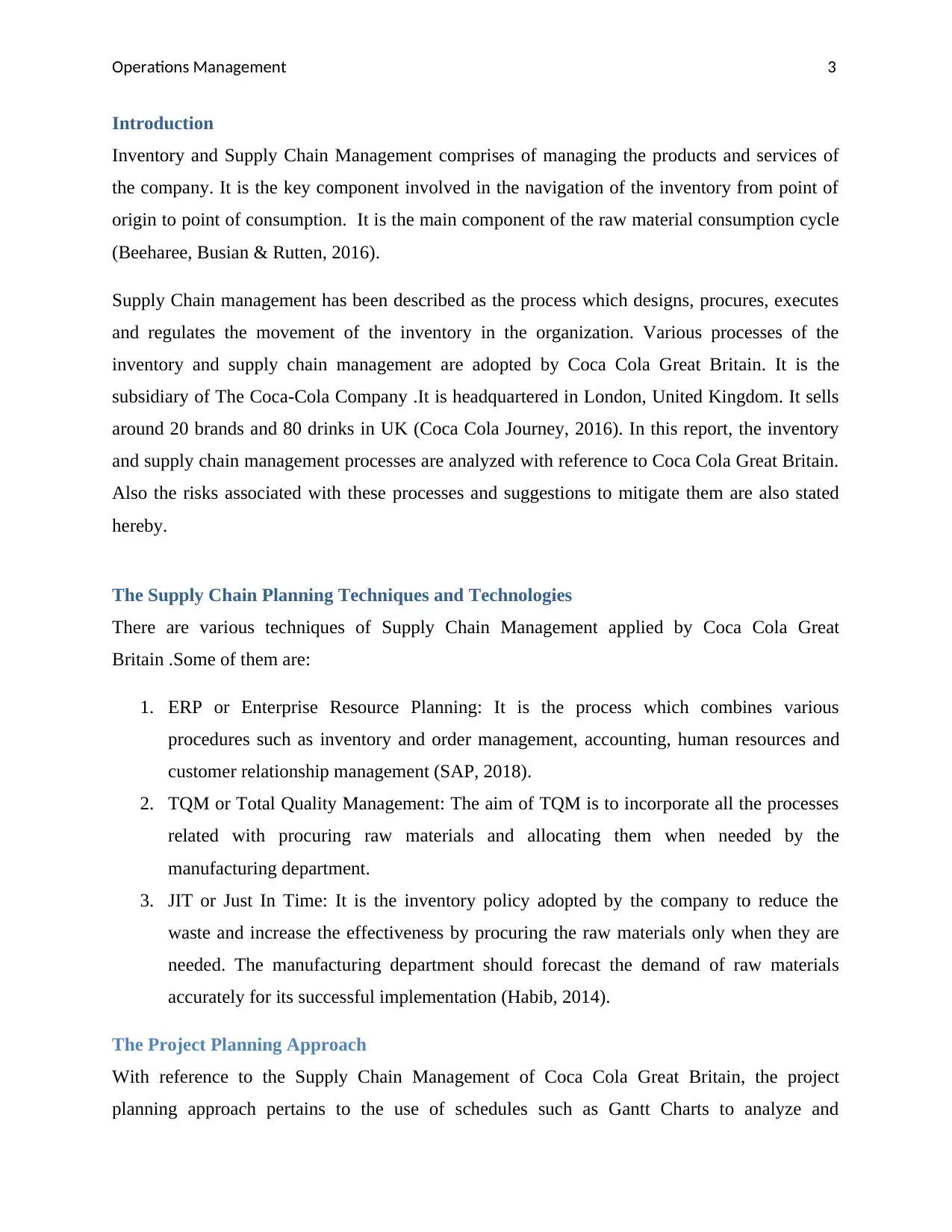
Operations Management 3
Introduction
Inventory and Supply Chain Management comprises of managing the products and services of
the company. It is the key component involved in the navigation of the inventory from point of
origin to point of consumption. It is the main component of the raw material consumption cycle
(Beeharee, Busian & Rutten, 2016).
Supply Chain management has been described as the process which designs, procures, executes
and regulates the movement of the inventory in the organization. Various processes of the
inventory and supply chain management are adopted by Coca Cola Great Britain. It is the
subsidiary of The Coca-Cola Company .It is headquartered in London, United Kingdom. It sells
around 20 brands and 80 drinks in UK (Coca Cola Journey, 2016). In this report, the inventory
and supply chain management processes are analyzed with reference to Coca Cola Great Britain.
Also the risks associated with these processes and suggestions to mitigate them are also stated
hereby.
The Supply Chain Planning Techniques and Technologies
There are various techniques of Supply Chain Management applied by Coca Cola Great
Britain .Some of them are:
1. ERP or Enterprise Resource Planning: It is the process which combines various
procedures such as inventory and order management, accounting, human resources and
customer relationship management (SAP, 2018).
2. TQM or Total Quality Management: The aim of TQM is to incorporate all the processes
related with procuring raw materials and allocating them when needed by the
manufacturing department.
3. JIT or Just In Time: It is the inventory policy adopted by the company to reduce the
waste and increase the effectiveness by procuring the raw materials only when they are
needed. The manufacturing department should forecast the demand of raw materials
accurately for its successful implementation (Habib, 2014).
The Project Planning Approach
With reference to the Supply Chain Management of Coca Cola Great Britain, the project
planning approach pertains to the use of schedules such as Gantt Charts to analyze and
Introduction
Inventory and Supply Chain Management comprises of managing the products and services of
the company. It is the key component involved in the navigation of the inventory from point of
origin to point of consumption. It is the main component of the raw material consumption cycle
(Beeharee, Busian & Rutten, 2016).
Supply Chain management has been described as the process which designs, procures, executes
and regulates the movement of the inventory in the organization. Various processes of the
inventory and supply chain management are adopted by Coca Cola Great Britain. It is the
subsidiary of The Coca-Cola Company .It is headquartered in London, United Kingdom. It sells
around 20 brands and 80 drinks in UK (Coca Cola Journey, 2016). In this report, the inventory
and supply chain management processes are analyzed with reference to Coca Cola Great Britain.
Also the risks associated with these processes and suggestions to mitigate them are also stated
hereby.
The Supply Chain Planning Techniques and Technologies
There are various techniques of Supply Chain Management applied by Coca Cola Great
Britain .Some of them are:
1. ERP or Enterprise Resource Planning: It is the process which combines various
procedures such as inventory and order management, accounting, human resources and
customer relationship management (SAP, 2018).
2. TQM or Total Quality Management: The aim of TQM is to incorporate all the processes
related with procuring raw materials and allocating them when needed by the
manufacturing department.
3. JIT or Just In Time: It is the inventory policy adopted by the company to reduce the
waste and increase the effectiveness by procuring the raw materials only when they are
needed. The manufacturing department should forecast the demand of raw materials
accurately for its successful implementation (Habib, 2014).
The Project Planning Approach
With reference to the Supply Chain Management of Coca Cola Great Britain, the project
planning approach pertains to the use of schedules such as Gantt Charts to analyze and
Secure Best Marks with AI Grader
Need help grading? Try our AI Grader for instant feedback on your assignments.

Operations Management 4
investigate the progress of the project. It is described as the use of suitable methodology to
complete the project and report its progress to the management (Wieland, 2013).
The Quality Improvement Approach
With reference to Coca Cola Great Britain, the Quality Improvement Approach pertains to
continuous observation and monitoring of the various processes at each level with the aim to
improve them. It establishes the policies and procedures to meet the consumer satisfaction and
product safety (Paiva, 2013).
Risks Associated with the Supply Chain Management
Several risks are identified in the Supply Chain Management of Coca Cola Great Britain. Some
of them are:
1. Supply Risks: When the flow of supply of raw material, work in progress and
finished products is disturbed due to some external factor such as non-availability of
the materials, labor strike and price hike, the system is prone to supply risk.
2. Demand Risk: When there is a sudden decrease in the demand for a certain product
due to volatile or misunderstood customer demands, the system is prone to demand
risk.
3. Environmental Risk: It exists outside the supply chain and is affected by economic,
social, administrative and climate factors.
4. Commercial Risk: When the company is unable to procure the raw material from the
market because of the withdrawal of the supplier to supply the goods and
management’s inability to purchase the goods due to financial constraints.
5. Risks relating to Non Compliance: When the company does not comply with the
applicable laws and regulations, it is prone to risk of noncompliance (Johnson, 2014).
6. Risk caused by disturbances in the manufacturing processes: The Company is prone
to risk caused by disruptions in the manufacturing procedures and mechanisms.
7. Planning and Control Risks: When the management fails to plan the proper
requirement and procurement of the raw materials, it is prone to planning and control
risks.
investigate the progress of the project. It is described as the use of suitable methodology to
complete the project and report its progress to the management (Wieland, 2013).
The Quality Improvement Approach
With reference to Coca Cola Great Britain, the Quality Improvement Approach pertains to
continuous observation and monitoring of the various processes at each level with the aim to
improve them. It establishes the policies and procedures to meet the consumer satisfaction and
product safety (Paiva, 2013).
Risks Associated with the Supply Chain Management
Several risks are identified in the Supply Chain Management of Coca Cola Great Britain. Some
of them are:
1. Supply Risks: When the flow of supply of raw material, work in progress and
finished products is disturbed due to some external factor such as non-availability of
the materials, labor strike and price hike, the system is prone to supply risk.
2. Demand Risk: When there is a sudden decrease in the demand for a certain product
due to volatile or misunderstood customer demands, the system is prone to demand
risk.
3. Environmental Risk: It exists outside the supply chain and is affected by economic,
social, administrative and climate factors.
4. Commercial Risk: When the company is unable to procure the raw material from the
market because of the withdrawal of the supplier to supply the goods and
management’s inability to purchase the goods due to financial constraints.
5. Risks relating to Non Compliance: When the company does not comply with the
applicable laws and regulations, it is prone to risk of noncompliance (Johnson, 2014).
6. Risk caused by disturbances in the manufacturing processes: The Company is prone
to risk caused by disruptions in the manufacturing procedures and mechanisms.
7. Planning and Control Risks: When the management fails to plan the proper
requirement and procurement of the raw materials, it is prone to planning and control
risks.

Operations Management 5
8. Change in the managerial personnel and risks associated with them: When there is a
change in the managerial personnel or processes pertaining to the change in the
ways of dealing with the suppliers and customers. With this the company might lose
the customers or suppliers, thereby bearing wastage of tie and resources to procure
new ones in their place.
9. Contingency Risks: When the management does not plan for alternative solutions for
the contingencies, it is prone to contingency risks.
10. Cultural Risk: When the company has the culture of concealing the negative
information and not resolving the issues and problems, it may not be able to react to
the issues and problems, when they arise suddenly (Queensland Government, 2017).
Mitigation of the risks associated with the Supply Chain Management
The PPRR Risk Management Model
The preparation, preparedness, response and recovery (PPRR) model is an effective approach to
risk management. It assists in tracing the impact of risk on Coca Cola Great Britain and helps to
reduce loss posed by the various threats. The steps of PPRR model are as follows:
1. Prevention: It enables the management to act by reducing the effects of risk or remove its
likelihood to occur.
2. Preparedness: With the help of this step, the management acts before the occurrence of
any incident. It helps the management to assure efficient response and recovery before
the company is exposed to any risk.
3. Response: It helps the management to control and reduce the impact of risk.
4. Recovery: It helps to implement certain measures to reduce the harm caused by the risk
and assists the business to recuperate from the loss suffered by the risk (Queensland
Government, 2017).
Financial Evaluation Techniques in the context of Supply Chain Management
Financial activities of the company are amongst its crucial and complex activities. So, in order
to fulfill the aim of the organization which pertains to minimizing cost and maximizing profits,
the managerial personnel should make sure that the funds are used in the most effective manner.
8. Change in the managerial personnel and risks associated with them: When there is a
change in the managerial personnel or processes pertaining to the change in the
ways of dealing with the suppliers and customers. With this the company might lose
the customers or suppliers, thereby bearing wastage of tie and resources to procure
new ones in their place.
9. Contingency Risks: When the management does not plan for alternative solutions for
the contingencies, it is prone to contingency risks.
10. Cultural Risk: When the company has the culture of concealing the negative
information and not resolving the issues and problems, it may not be able to react to
the issues and problems, when they arise suddenly (Queensland Government, 2017).
Mitigation of the risks associated with the Supply Chain Management
The PPRR Risk Management Model
The preparation, preparedness, response and recovery (PPRR) model is an effective approach to
risk management. It assists in tracing the impact of risk on Coca Cola Great Britain and helps to
reduce loss posed by the various threats. The steps of PPRR model are as follows:
1. Prevention: It enables the management to act by reducing the effects of risk or remove its
likelihood to occur.
2. Preparedness: With the help of this step, the management acts before the occurrence of
any incident. It helps the management to assure efficient response and recovery before
the company is exposed to any risk.
3. Response: It helps the management to control and reduce the impact of risk.
4. Recovery: It helps to implement certain measures to reduce the harm caused by the risk
and assists the business to recuperate from the loss suffered by the risk (Queensland
Government, 2017).
Financial Evaluation Techniques in the context of Supply Chain Management
Financial activities of the company are amongst its crucial and complex activities. So, in order
to fulfill the aim of the organization which pertains to minimizing cost and maximizing profits,
the managerial personnel should make sure that the funds are used in the most effective manner.
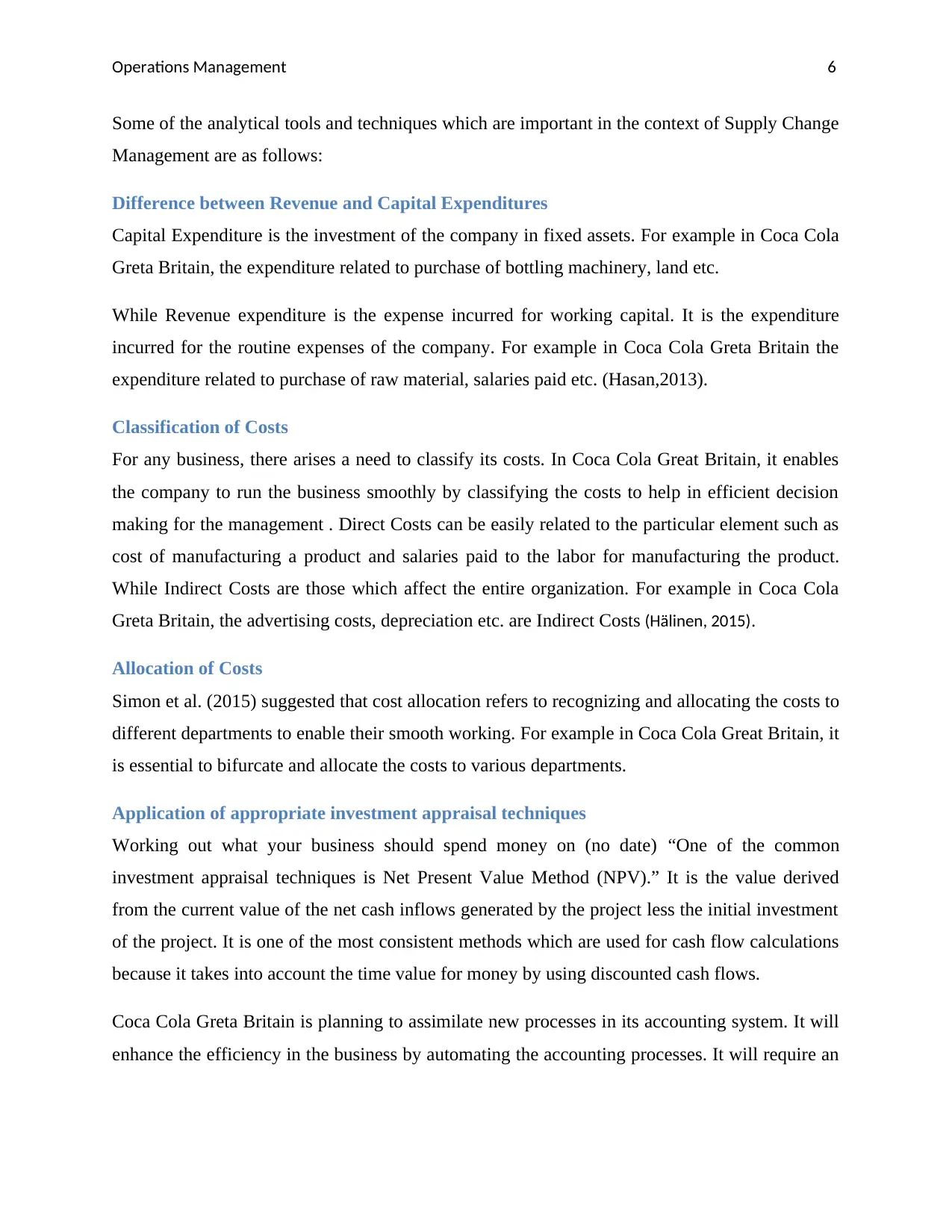
Operations Management 6
Some of the analytical tools and techniques which are important in the context of Supply Change
Management are as follows:
Difference between Revenue and Capital Expenditures
Capital Expenditure is the investment of the company in fixed assets. For example in Coca Cola
Greta Britain, the expenditure related to purchase of bottling machinery, land etc.
While Revenue expenditure is the expense incurred for working capital. It is the expenditure
incurred for the routine expenses of the company. For example in Coca Cola Greta Britain the
expenditure related to purchase of raw material, salaries paid etc. (Hasan,2013).
Classification of Costs
For any business, there arises a need to classify its costs. In Coca Cola Great Britain, it enables
the company to run the business smoothly by classifying the costs to help in efficient decision
making for the management . Direct Costs can be easily related to the particular element such as
cost of manufacturing a product and salaries paid to the labor for manufacturing the product.
While Indirect Costs are those which affect the entire organization. For example in Coca Cola
Greta Britain, the advertising costs, depreciation etc. are Indirect Costs (Hälinen, 2015).
Allocation of Costs
Simon et al. (2015) suggested that cost allocation refers to recognizing and allocating the costs to
different departments to enable their smooth working. For example in Coca Cola Great Britain, it
is essential to bifurcate and allocate the costs to various departments.
Application of appropriate investment appraisal techniques
Working out what your business should spend money on (no date) “One of the common
investment appraisal techniques is Net Present Value Method (NPV).” It is the value derived
from the current value of the net cash inflows generated by the project less the initial investment
of the project. It is one of the most consistent methods which are used for cash flow calculations
because it takes into account the time value for money by using discounted cash flows.
Coca Cola Greta Britain is planning to assimilate new processes in its accounting system. It will
enhance the efficiency in the business by automating the accounting processes. It will require an
Some of the analytical tools and techniques which are important in the context of Supply Change
Management are as follows:
Difference between Revenue and Capital Expenditures
Capital Expenditure is the investment of the company in fixed assets. For example in Coca Cola
Greta Britain, the expenditure related to purchase of bottling machinery, land etc.
While Revenue expenditure is the expense incurred for working capital. It is the expenditure
incurred for the routine expenses of the company. For example in Coca Cola Greta Britain the
expenditure related to purchase of raw material, salaries paid etc. (Hasan,2013).
Classification of Costs
For any business, there arises a need to classify its costs. In Coca Cola Great Britain, it enables
the company to run the business smoothly by classifying the costs to help in efficient decision
making for the management . Direct Costs can be easily related to the particular element such as
cost of manufacturing a product and salaries paid to the labor for manufacturing the product.
While Indirect Costs are those which affect the entire organization. For example in Coca Cola
Greta Britain, the advertising costs, depreciation etc. are Indirect Costs (Hälinen, 2015).
Allocation of Costs
Simon et al. (2015) suggested that cost allocation refers to recognizing and allocating the costs to
different departments to enable their smooth working. For example in Coca Cola Great Britain, it
is essential to bifurcate and allocate the costs to various departments.
Application of appropriate investment appraisal techniques
Working out what your business should spend money on (no date) “One of the common
investment appraisal techniques is Net Present Value Method (NPV).” It is the value derived
from the current value of the net cash inflows generated by the project less the initial investment
of the project. It is one of the most consistent methods which are used for cash flow calculations
because it takes into account the time value for money by using discounted cash flows.
Coca Cola Greta Britain is planning to assimilate new processes in its accounting system. It will
enhance the efficiency in the business by automating the accounting processes. It will require an
Paraphrase This Document
Need a fresh take? Get an instant paraphrase of this document with our AI Paraphraser
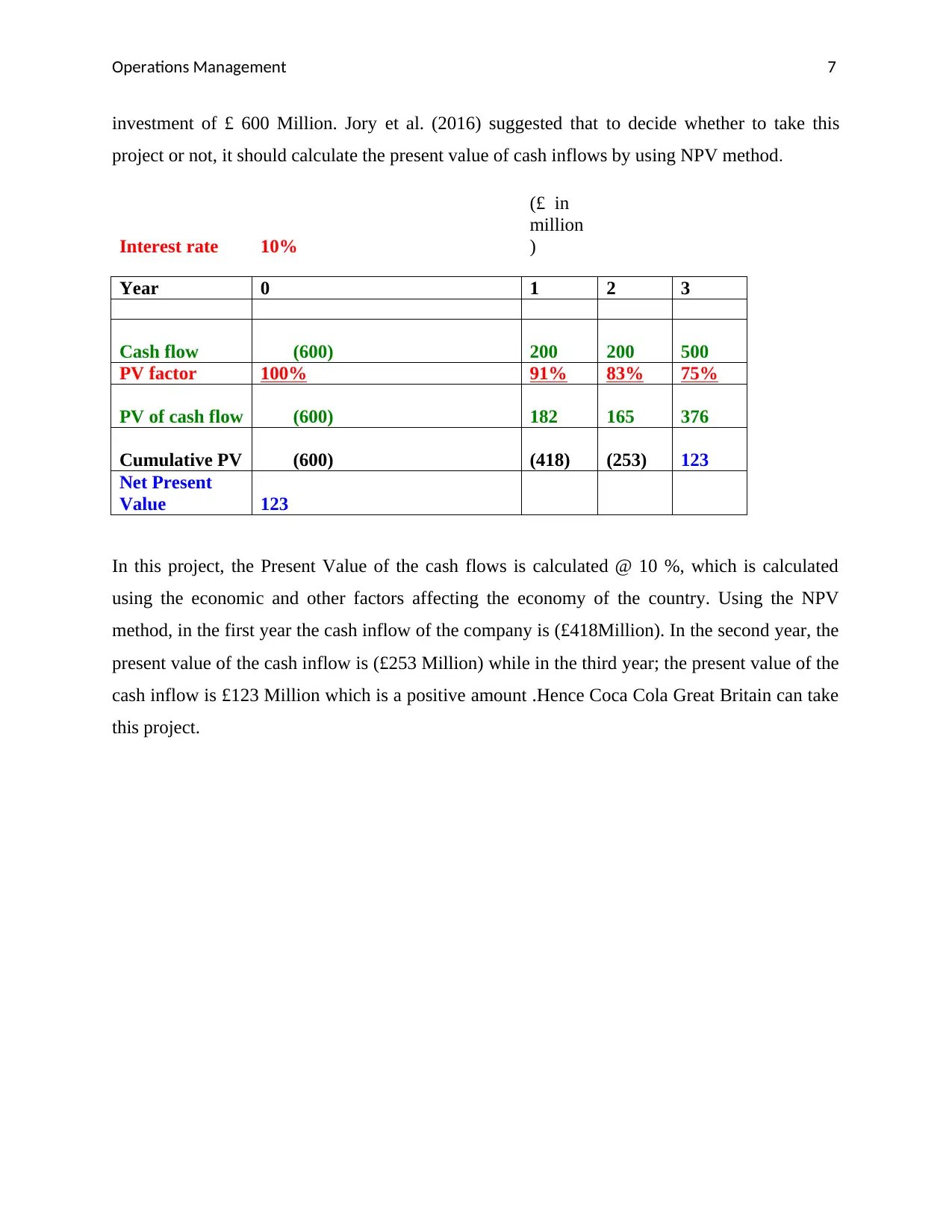
Operations Management 7
investment of £ 600 Million. Jory et al. (2016) suggested that to decide whether to take this
project or not, it should calculate the present value of cash inflows by using NPV method.
Interest rate 10%
(£ in
million
)
Year 0 1 2 3
Cash flow (600) 200 200 500
PV factor 100% 91% 83% 75%
PV of cash flow (600) 182 165 376
Cumulative PV (600) (418) (253) 123
Net Present
Value 123
In this project, the Present Value of the cash flows is calculated @ 10 %, which is calculated
using the economic and other factors affecting the economy of the country. Using the NPV
method, in the first year the cash inflow of the company is (£418Million). In the second year, the
present value of the cash inflow is (£253 Million) while in the third year; the present value of the
cash inflow is £123 Million which is a positive amount .Hence Coca Cola Great Britain can take
this project.
investment of £ 600 Million. Jory et al. (2016) suggested that to decide whether to take this
project or not, it should calculate the present value of cash inflows by using NPV method.
Interest rate 10%
(£ in
million
)
Year 0 1 2 3
Cash flow (600) 200 200 500
PV factor 100% 91% 83% 75%
PV of cash flow (600) 182 165 376
Cumulative PV (600) (418) (253) 123
Net Present
Value 123
In this project, the Present Value of the cash flows is calculated @ 10 %, which is calculated
using the economic and other factors affecting the economy of the country. Using the NPV
method, in the first year the cash inflow of the company is (£418Million). In the second year, the
present value of the cash inflow is (£253 Million) while in the third year; the present value of the
cash inflow is £123 Million which is a positive amount .Hence Coca Cola Great Britain can take
this project.
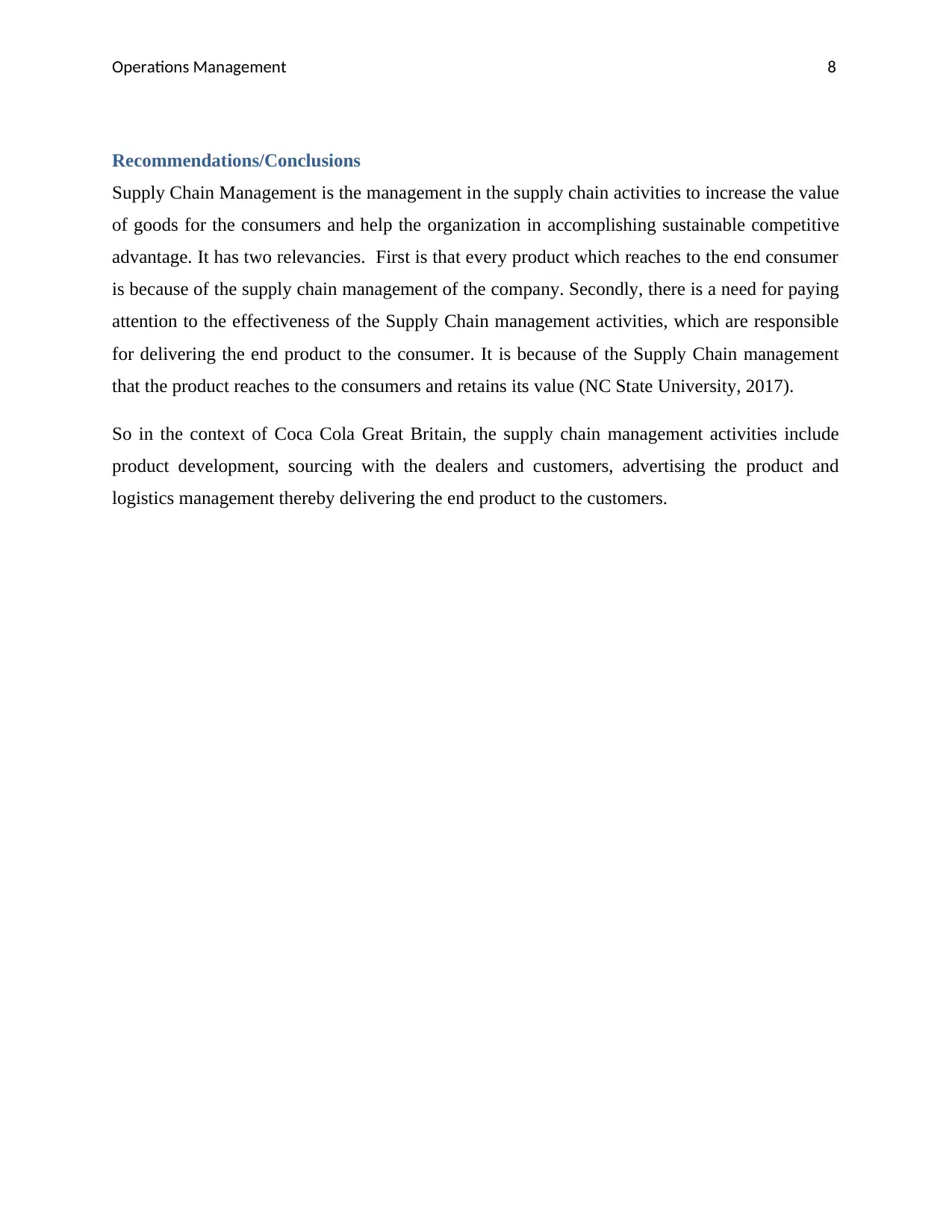
Operations Management 8
Recommendations/Conclusions
Supply Chain Management is the management in the supply chain activities to increase the value
of goods for the consumers and help the organization in accomplishing sustainable competitive
advantage. It has two relevancies. First is that every product which reaches to the end consumer
is because of the supply chain management of the company. Secondly, there is a need for paying
attention to the effectiveness of the Supply Chain management activities, which are responsible
for delivering the end product to the consumer. It is because of the Supply Chain management
that the product reaches to the consumers and retains its value (NC State University, 2017).
So in the context of Coca Cola Great Britain, the supply chain management activities include
product development, sourcing with the dealers and customers, advertising the product and
logistics management thereby delivering the end product to the customers.
Recommendations/Conclusions
Supply Chain Management is the management in the supply chain activities to increase the value
of goods for the consumers and help the organization in accomplishing sustainable competitive
advantage. It has two relevancies. First is that every product which reaches to the end consumer
is because of the supply chain management of the company. Secondly, there is a need for paying
attention to the effectiveness of the Supply Chain management activities, which are responsible
for delivering the end product to the consumer. It is because of the Supply Chain management
that the product reaches to the consumers and retains its value (NC State University, 2017).
So in the context of Coca Cola Great Britain, the supply chain management activities include
product development, sourcing with the dealers and customers, advertising the product and
logistics management thereby delivering the end product to the customers.
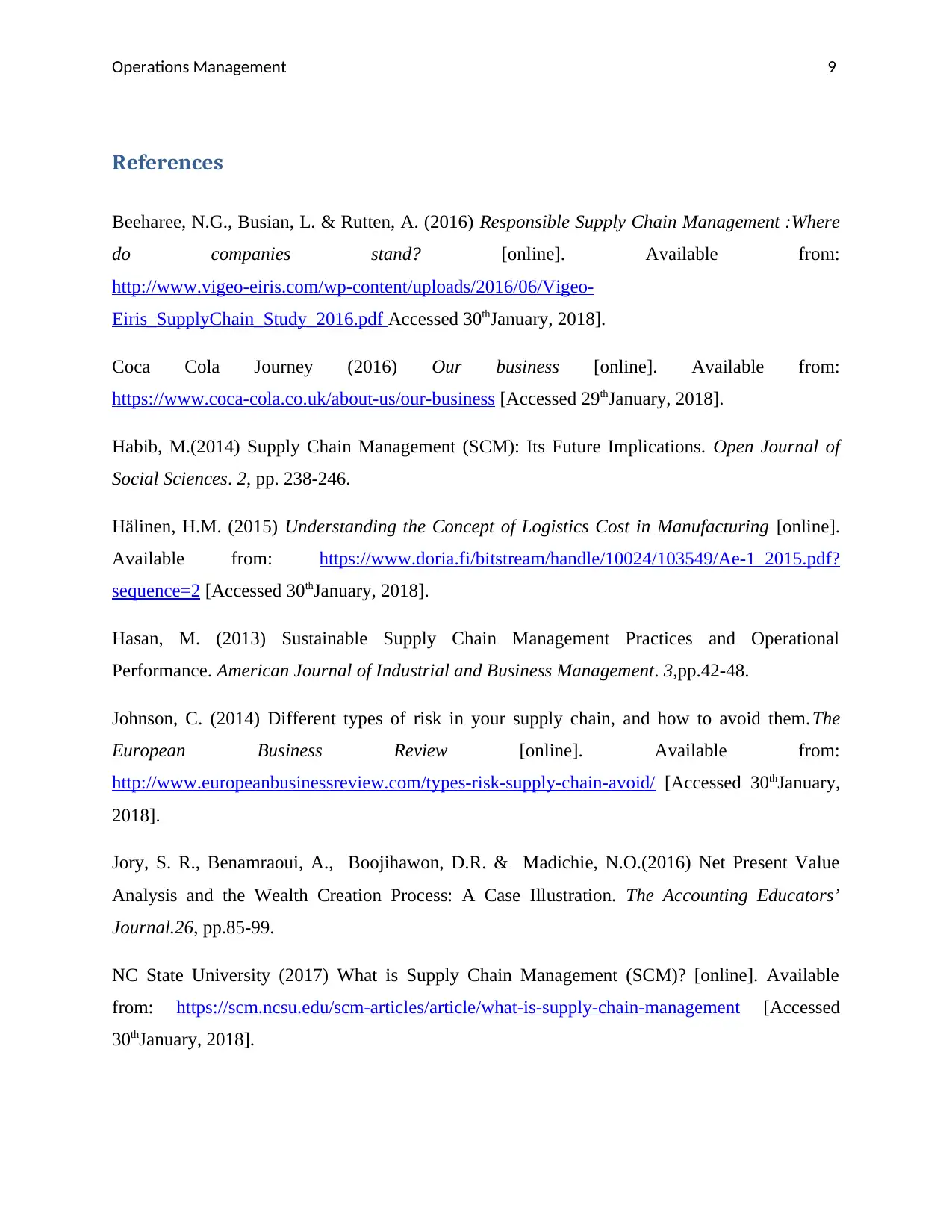
Operations Management 9
References
Beeharee, N.G., Busian, L. & Rutten, A. (2016) Responsible Supply Chain Management :Where
do companies stand? [online]. Available from:
http://www.vigeo-eiris.com/wp-content/uploads/2016/06/Vigeo-
Eiris_SupplyChain_Study_2016.pdf Accessed 30thJanuary, 2018].
Coca Cola Journey (2016) Our business [online]. Available from:
https://www.coca-cola.co.uk/about-us/our-business [Accessed 29thJanuary, 2018].
Habib, M.(2014) Supply Chain Management (SCM): Its Future Implications. Open Journal of
Social Sciences. 2, pp. 238-246.
Hälinen, H.M. (2015) Understanding the Concept of Logistics Cost in Manufacturing [online].
Available from: https://www.doria.fi/bitstream/handle/10024/103549/Ae-1_2015.pdf?
sequence=2 [Accessed 30thJanuary, 2018].
Hasan, M. (2013) Sustainable Supply Chain Management Practices and Operational
Performance. American Journal of Industrial and Business Management. 3,pp.42-48.
Johnson, C. (2014) Different types of risk in your supply chain, and how to avoid them. The
European Business Review [online]. Available from:
http://www.europeanbusinessreview.com/types-risk-supply-chain-avoid/ [Accessed 30thJanuary,
2018].
Jory, S. R., Benamraoui, A., Boojihawon, D.R. & Madichie, N.O.(2016) Net Present Value
Analysis and the Wealth Creation Process: A Case Illustration. The Accounting Educators’
Journal.26, pp.85-99.
NC State University (2017) What is Supply Chain Management (SCM)? [online]. Available
from: https://scm.ncsu.edu/scm-articles/article/what-is-supply-chain-management [Accessed
30thJanuary, 2018].
References
Beeharee, N.G., Busian, L. & Rutten, A. (2016) Responsible Supply Chain Management :Where
do companies stand? [online]. Available from:
http://www.vigeo-eiris.com/wp-content/uploads/2016/06/Vigeo-
Eiris_SupplyChain_Study_2016.pdf Accessed 30thJanuary, 2018].
Coca Cola Journey (2016) Our business [online]. Available from:
https://www.coca-cola.co.uk/about-us/our-business [Accessed 29thJanuary, 2018].
Habib, M.(2014) Supply Chain Management (SCM): Its Future Implications. Open Journal of
Social Sciences. 2, pp. 238-246.
Hälinen, H.M. (2015) Understanding the Concept of Logistics Cost in Manufacturing [online].
Available from: https://www.doria.fi/bitstream/handle/10024/103549/Ae-1_2015.pdf?
sequence=2 [Accessed 30thJanuary, 2018].
Hasan, M. (2013) Sustainable Supply Chain Management Practices and Operational
Performance. American Journal of Industrial and Business Management. 3,pp.42-48.
Johnson, C. (2014) Different types of risk in your supply chain, and how to avoid them. The
European Business Review [online]. Available from:
http://www.europeanbusinessreview.com/types-risk-supply-chain-avoid/ [Accessed 30thJanuary,
2018].
Jory, S. R., Benamraoui, A., Boojihawon, D.R. & Madichie, N.O.(2016) Net Present Value
Analysis and the Wealth Creation Process: A Case Illustration. The Accounting Educators’
Journal.26, pp.85-99.
NC State University (2017) What is Supply Chain Management (SCM)? [online]. Available
from: https://scm.ncsu.edu/scm-articles/article/what-is-supply-chain-management [Accessed
30thJanuary, 2018].
Secure Best Marks with AI Grader
Need help grading? Try our AI Grader for instant feedback on your assignments.
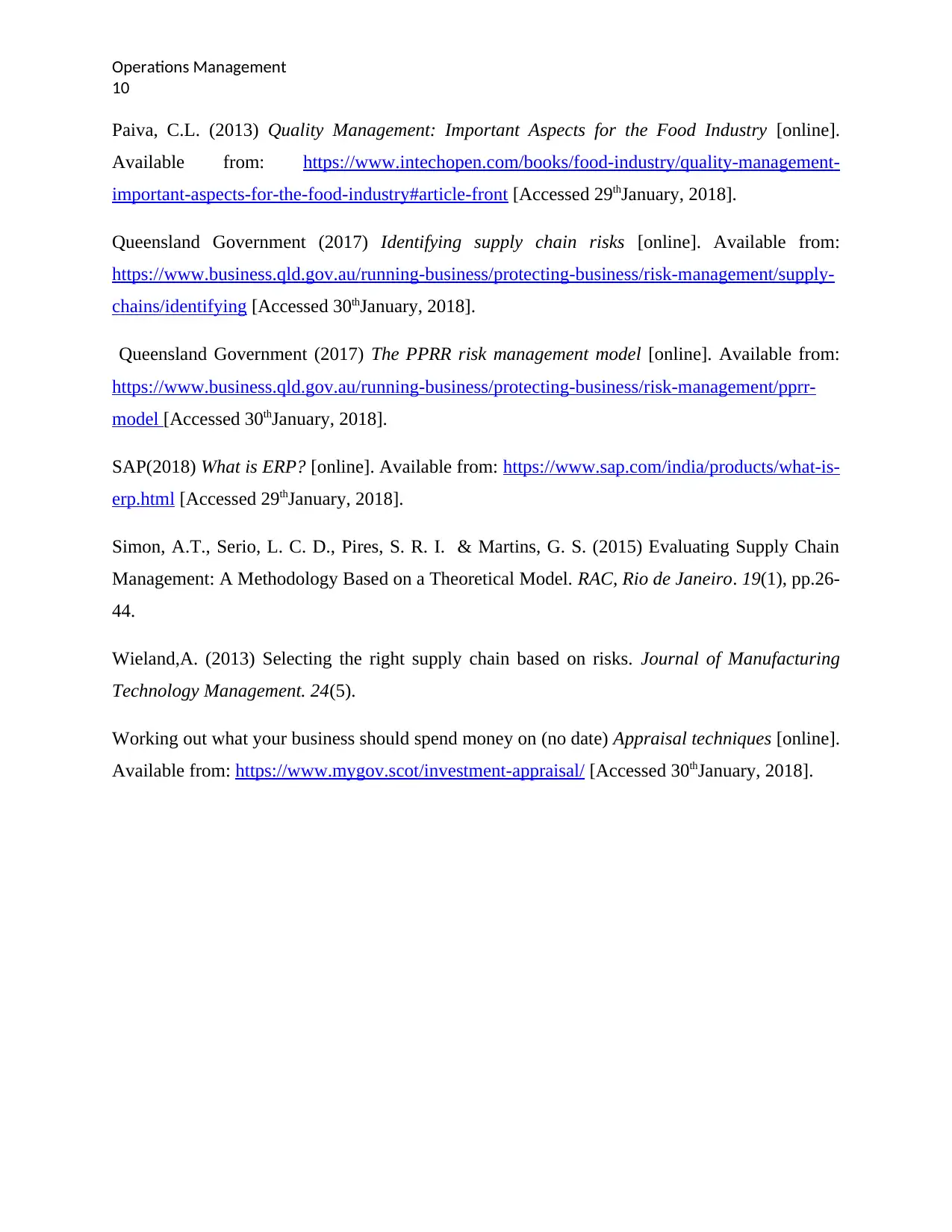
Operations Management
10
Paiva, C.L. (2013) Quality Management: Important Aspects for the Food Industry [online].
Available from: https://www.intechopen.com/books/food-industry/quality-management-
important-aspects-for-the-food-industry#article-front [Accessed 29thJanuary, 2018].
Queensland Government (2017) Identifying supply chain risks [online]. Available from:
https://www.business.qld.gov.au/running-business/protecting-business/risk-management/supply-
chains/identifying [Accessed 30thJanuary, 2018].
Queensland Government (2017) The PPRR risk management model [online]. Available from:
https://www.business.qld.gov.au/running-business/protecting-business/risk-management/pprr-
model [Accessed 30thJanuary, 2018].
SAP(2018) What is ERP? [online]. Available from: https://www.sap.com/india/products/what-is-
erp.html [Accessed 29thJanuary, 2018].
Simon, A.T., Serio, L. C. D., Pires, S. R. I. & Martins, G. S. (2015) Evaluating Supply Chain
Management: A Methodology Based on a Theoretical Model. RAC, Rio de Janeiro. 19(1), pp.26-
44.
Wieland,A. (2013) Selecting the right supply chain based on risks. Journal of Manufacturing
Technology Management. 24(5).
Working out what your business should spend money on (no date) Appraisal techniques [online].
Available from: https://www.mygov.scot/investment-appraisal/ [Accessed 30thJanuary, 2018].
10
Paiva, C.L. (2013) Quality Management: Important Aspects for the Food Industry [online].
Available from: https://www.intechopen.com/books/food-industry/quality-management-
important-aspects-for-the-food-industry#article-front [Accessed 29thJanuary, 2018].
Queensland Government (2017) Identifying supply chain risks [online]. Available from:
https://www.business.qld.gov.au/running-business/protecting-business/risk-management/supply-
chains/identifying [Accessed 30thJanuary, 2018].
Queensland Government (2017) The PPRR risk management model [online]. Available from:
https://www.business.qld.gov.au/running-business/protecting-business/risk-management/pprr-
model [Accessed 30thJanuary, 2018].
SAP(2018) What is ERP? [online]. Available from: https://www.sap.com/india/products/what-is-
erp.html [Accessed 29thJanuary, 2018].
Simon, A.T., Serio, L. C. D., Pires, S. R. I. & Martins, G. S. (2015) Evaluating Supply Chain
Management: A Methodology Based on a Theoretical Model. RAC, Rio de Janeiro. 19(1), pp.26-
44.
Wieland,A. (2013) Selecting the right supply chain based on risks. Journal of Manufacturing
Technology Management. 24(5).
Working out what your business should spend money on (no date) Appraisal techniques [online].
Available from: https://www.mygov.scot/investment-appraisal/ [Accessed 30thJanuary, 2018].
1 out of 11
Related Documents
Your All-in-One AI-Powered Toolkit for Academic Success.
+13062052269
info@desklib.com
Available 24*7 on WhatsApp / Email
![[object Object]](/_next/static/media/star-bottom.7253800d.svg)
Unlock your academic potential
© 2024 | Zucol Services PVT LTD | All rights reserved.





